power steering PONTIAC VIBE 2007 Owners Manual
[x] Cancel search | Manufacturer: PONTIAC, Model Year: 2007, Model line: VIBE, Model: PONTIAC VIBE 2007Pages: 432, PDF Size: 2.54 MB
Page 122 of 432
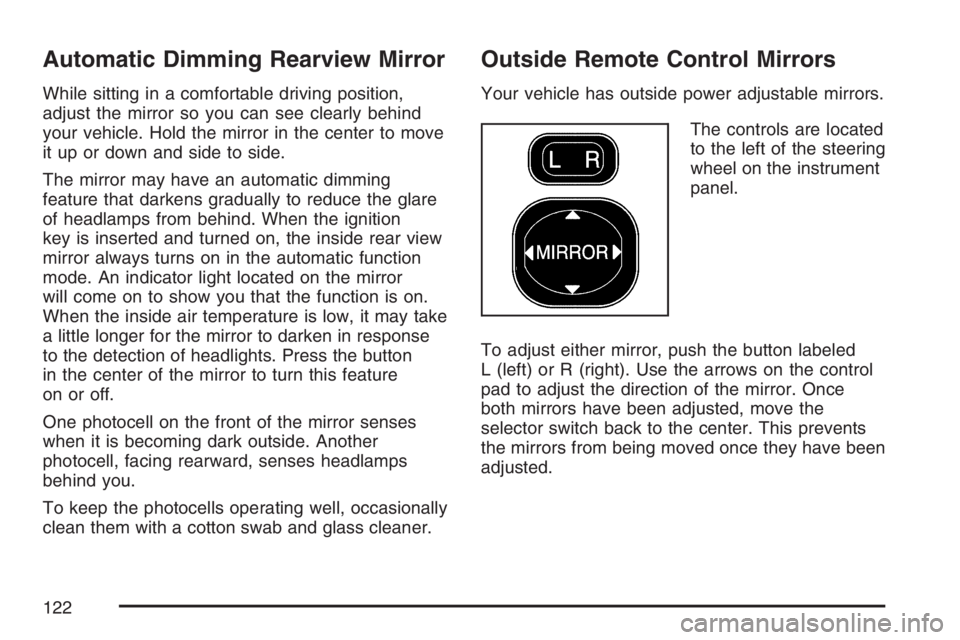
Automatic Dimming Rearview Mirror
While sitting in a comfortable driving position,
adjust the mirror so you can see clearly behind
your vehicle. Hold the mirror in the center to move
it up or down and side to side.
The mirror may have an automatic dimming
feature that darkens gradually to reduce the glare
of headlamps from behind. When the ignition
key is inserted and turned on, the inside rear view
mirror always turns on in the automatic function
mode. An indicator light located on the mirror
will come on to show you that the function is on.
When the inside air temperature is low, it may take
a little longer for the mirror to darken in response
to the detection of headlights. Press the button
in the center of the mirror to turn this feature
on or off.
One photocell on the front of the mirror senses
when it is becoming dark outside. Another
photocell, facing rearward, senses headlamps
behind you.
To keep the photocells operating well, occasionally
clean them with a cotton swab and glass cleaner.
Outside Remote Control Mirrors
Your vehicle has outside power adjustable mirrors.
The controls are located
to the left of the steering
wheel on the instrument
panel.
To adjust either mirror, push the button labeled
L (left) or R (right). Use the arrows on the control
pad to adjust the direction of the mirror. Once
both mirrors have been adjusted, move the
selector switch back to the center. This prevents
the mirrors from being moved once they have been
adjusted.
122
Page 138 of 432
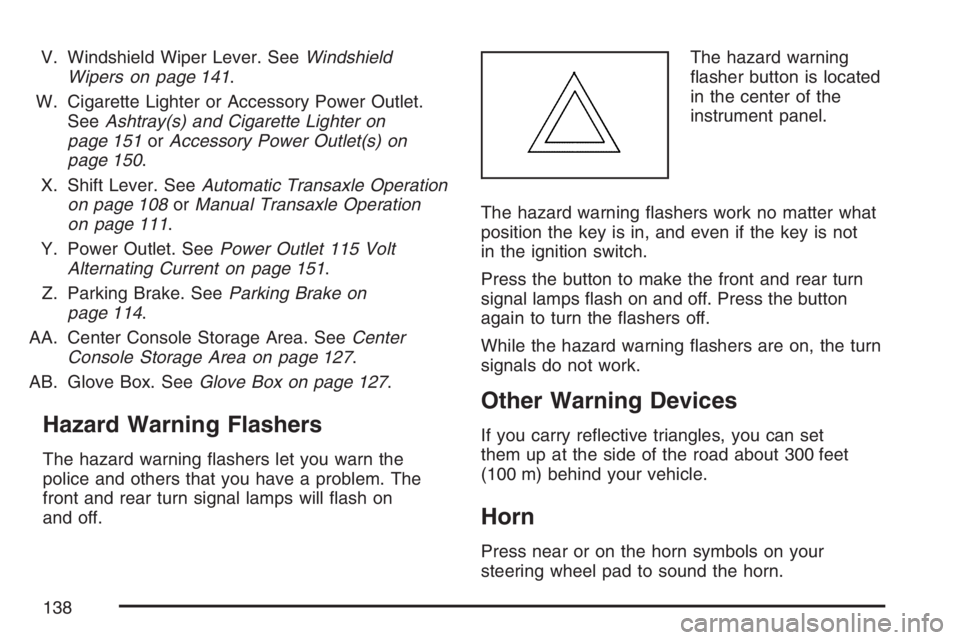
V. Windshield Wiper Lever. SeeWindshield
Wipers on page 141.
W. Cigarette Lighter or Accessory Power Outlet.
SeeAshtray(s) and Cigarette Lighter on
page 151orAccessory Power Outlet(s) on
page 150.
X. Shift Lever. SeeAutomatic Transaxle Operation
on page 108orManual Transaxle Operation
on page 111.
Y. Power Outlet. SeePower Outlet 115 Volt
Alternating Current on page 151.
Z. Parking Brake. SeeParking Brake on
page 114.
AA. Center Console Storage Area. SeeCenter
Console Storage Area on page 127.
AB. Glove Box. SeeGlove Box on page 127.
Hazard Warning Flashers
The hazard warning �ashers let you warn the
police and others that you have a problem. The
front and rear turn signal lamps will �ash on
and off.The hazard warning
�asher button is located
in the center of the
instrument panel.
The hazard warning �ashers work no matter what
position the key is in, and even if the key is not
in the ignition switch.
Press the button to make the front and rear turn
signal lamps �ash on and off. Press the button
again to turn the �ashers off.
While the hazard warning �ashers are on, the turn
signals do not work.
Other Warning Devices
If you carry re�ective triangles, you can set
them up at the side of the road about 300 feet
(100 m) behind your vehicle.
Horn
Press near or on the horn symbols on your
steering wheel pad to sound the horn.
138
Page 229 of 432
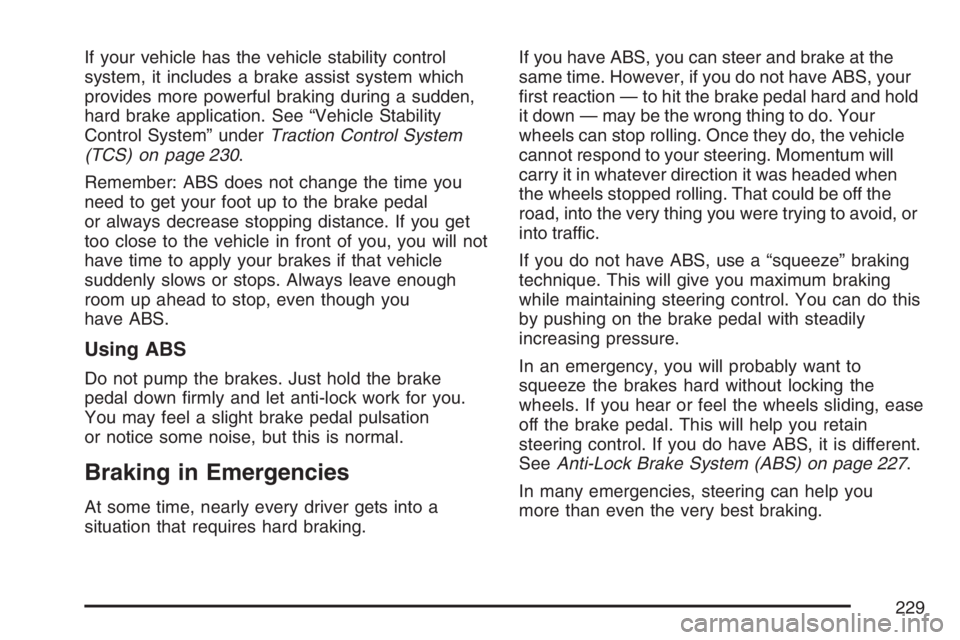
If your vehicle has the vehicle stability control
system, it includes a brake assist system which
provides more powerful braking during a sudden,
hard brake application. See “Vehicle Stability
Control System” underTraction Control System
(TCS) on page 230.
Remember: ABS does not change the time you
need to get your foot up to the brake pedal
or always decrease stopping distance. If you get
too close to the vehicle in front of you, you will not
have time to apply your brakes if that vehicle
suddenly slows or stops. Always leave enough
room up ahead to stop, even though you
have ABS.
Using ABS
Do not pump the brakes. Just hold the brake
pedal down �rmly and let anti-lock work for you.
You may feel a slight brake pedal pulsation
or notice some noise, but this is normal.
Braking in Emergencies
At some time, nearly every driver gets into a
situation that requires hard braking.If you have ABS, you can steer and brake at the
same time. However, if you do not have ABS, your
�rst reaction — to hit the brake pedal hard and hold
it down — may be the wrong thing to do. Your
wheels can stop rolling. Once they do, the vehicle
cannot respond to your steering. Momentum will
carry it in whatever direction it was headed when
the wheels stopped rolling. That could be off the
road, into the very thing you were trying to avoid, or
into traffic.
If you do not have ABS, use a “squeeze” braking
technique. This will give you maximum braking
while maintaining steering control. You can do this
by pushing on the brake pedal with steadily
increasing pressure.
In an emergency, you will probably want to
squeeze the brakes hard without locking the
wheels. If you hear or feel the wheels sliding, ease
off the brake pedal. This will help you retain
steering control. If you do have ABS, it is different.
SeeAnti-Lock Brake System (ABS) on page 227.
In many emergencies, steering can help you
more than even the very best braking.
229
Page 230 of 432
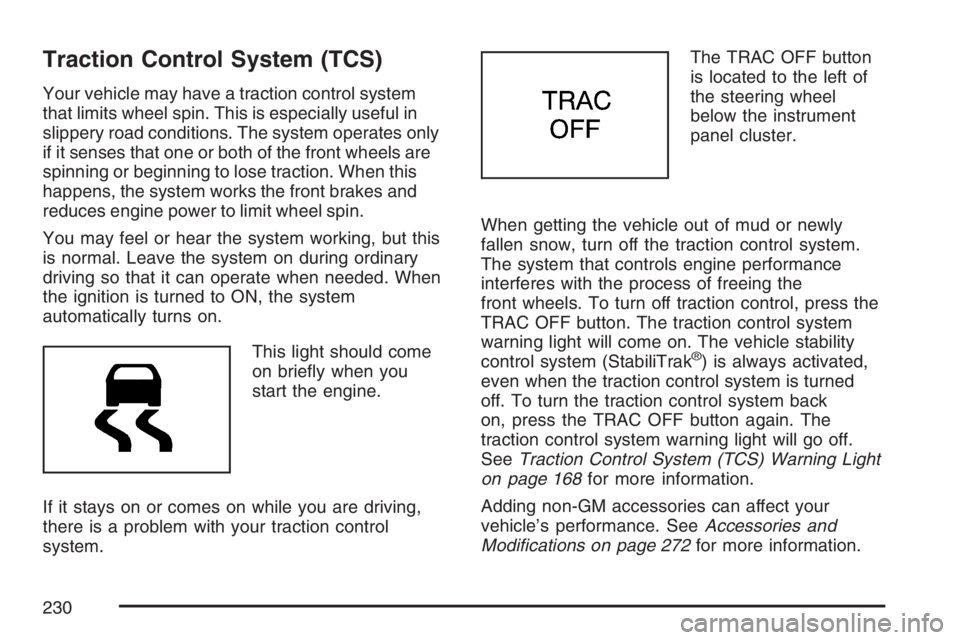
Traction Control System (TCS)
Your vehicle may have a traction control system
that limits wheel spin. This is especially useful in
slippery road conditions. The system operates only
if it senses that one or both of the front wheels are
spinning or beginning to lose traction. When this
happens, the system works the front brakes and
reduces engine power to limit wheel spin.
You may feel or hear the system working, but this
is normal. Leave the system on during ordinary
driving so that it can operate when needed. When
the ignition is turned to ON, the system
automatically turns on.
This light should come
on brie�y when you
start the engine.
If it stays on or comes on while you are driving,
there is a problem with your traction control
system.The TRAC OFF button
is located to the left of
the steering wheel
below the instrument
panel cluster.
When getting the vehicle out of mud or newly
fallen snow, turn off the traction control system.
The system that controls engine performance
interferes with the process of freeing the
front wheels. To turn off traction control, press the
TRAC OFF button. The traction control system
warning light will come on. The vehicle stability
control system (StabiliTrak
®) is always activated,
even when the traction control system is turned
off. To turn the traction control system back
on, press the TRAC OFF button again. The
traction control system warning light will go off.
SeeTraction Control System (TCS) Warning Light
on page 168for more information.
Adding non-GM accessories can affect your
vehicle’s performance. SeeAccessories and
Modi�cations on page 272for more information.
230
Page 232 of 432
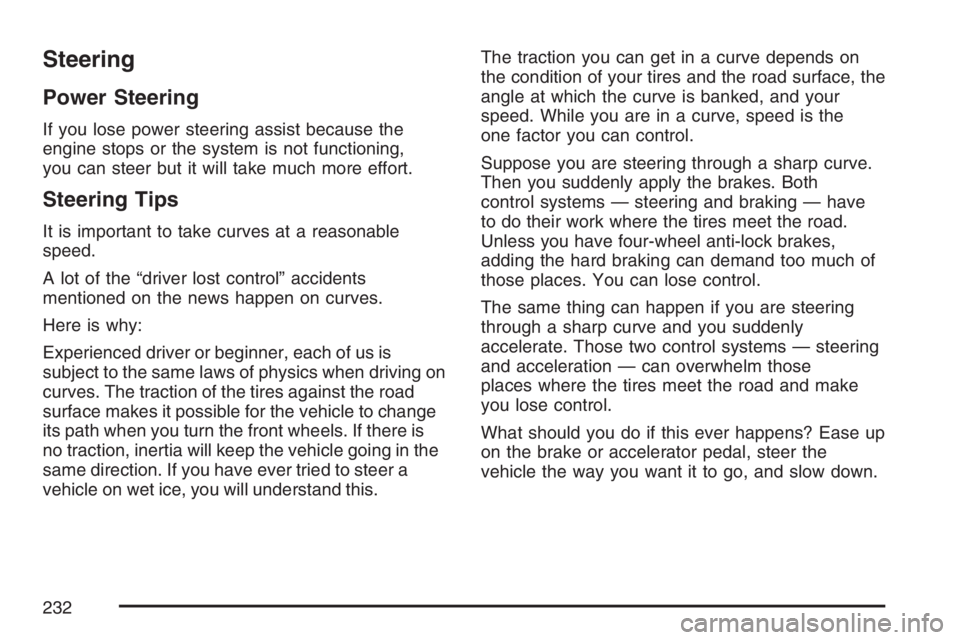
Steering
Power Steering
If you lose power steering assist because the
engine stops or the system is not functioning,
you can steer but it will take much more effort.
Steering Tips
It is important to take curves at a reasonable
speed.
A lot of the “driver lost control” accidents
mentioned on the news happen on curves.
Here is why:
Experienced driver or beginner, each of us is
subject to the same laws of physics when driving on
curves. The traction of the tires against the road
surface makes it possible for the vehicle to change
its path when you turn the front wheels. If there is
no traction, inertia will keep the vehicle going in the
same direction. If you have ever tried to steer a
vehicle on wet ice, you will understand this.The traction you can get in a curve depends on
the condition of your tires and the road surface, the
angle at which the curve is banked, and your
speed. While you are in a curve, speed is the
one factor you can control.
Suppose you are steering through a sharp curve.
Then you suddenly apply the brakes. Both
control systems — steering and braking — have
to do their work where the tires meet the road.
Unless you have four-wheel anti-lock brakes,
adding the hard braking can demand too much of
those places. You can lose control.
The same thing can happen if you are steering
through a sharp curve and you suddenly
accelerate. Those two control systems — steering
and acceleration — can overwhelm those
places where the tires meet the road and make
you lose control.
What should you do if this ever happens? Ease up
on the brake or accelerator pedal, steer the
vehicle the way you want it to go, and slow down.
232
Page 260 of 432
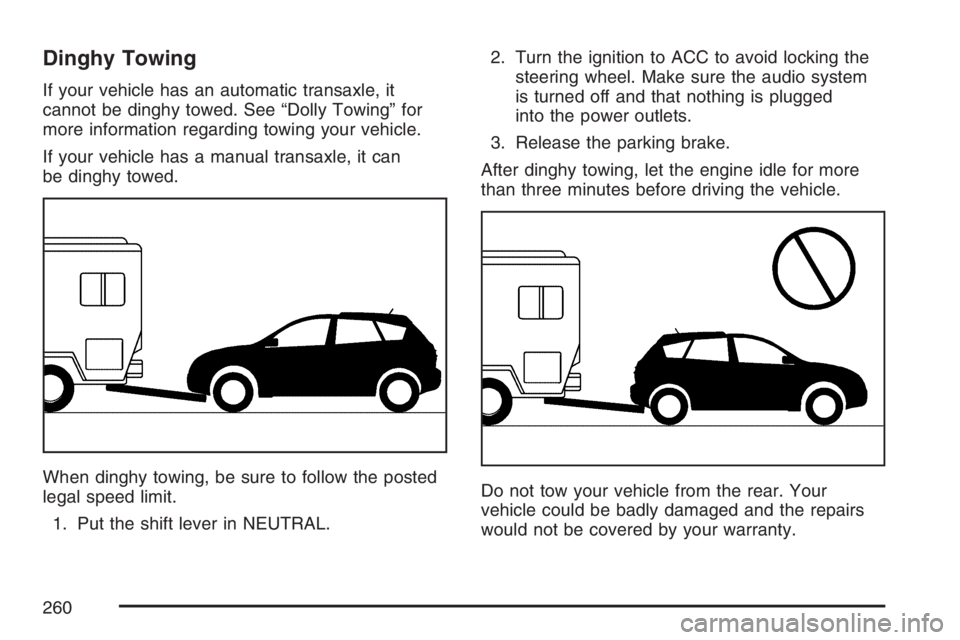
Dinghy Towing
If your vehicle has an automatic transaxle, it
cannot be dinghy towed. See “Dolly Towing” for
more information regarding towing your vehicle.
If your vehicle has a manual transaxle, it can
be dinghy towed.
When dinghy towing, be sure to follow the posted
legal speed limit.
1. Put the shift lever in NEUTRAL.2. Turn the ignition to ACC to avoid locking the
steering wheel. Make sure the audio system
is turned off and that nothing is plugged
into the power outlets.
3. Release the parking brake.
After dinghy towing, let the engine idle for more
than three minutes before driving the vehicle.
Do not tow your vehicle from the rear. Your
vehicle could be badly damaged and the repairs
would not be covered by your warranty.
260
Page 269 of 432

Service........................................................ 272
Accessories and Modi�cations................... 272
California Proposition 65 Warning.............. 273
Doing Your Own Service Work.................. 273
Adding Equipment to the Outside of
Your Vehicle.......................................... 274
Fuel............................................................. 274
Gasoline Octane........................................ 274
Gasoline Speci�cations.............................. 274
California Fuel........................................... 275
Additives................................................... 275
Fuels in Foreign Countries........................ 276
Filling the Tank......................................... 277
Filling a Portable Fuel Container............... 279
Checking Things Under the Hood.............. 280
Hood Release........................................... 280
Engine Compartment Overview.................. 282
Engine Oil................................................. 284
Engine Air Cleaner/Filter............................ 288
Automatic Transaxle Fluid......................... 290Manual Transaxle Fluid............................. 292
Hydraulic Clutch........................................ 293
Engine Coolant.......................................... 294
Radiator Pressure Cap.............................. 297
Engine Overheating................................... 297
Cooling System......................................... 299
Power Steering Fluid ................................. 304
Windshield Washer Fluid........................... 305
Brakes...................................................... 306
Battery...................................................... 309
Jump Starting............................................ 310
Bulb Replacement....................................... 315
Halogen Bulbs........................................... 315
Headlamps, Front Turn Signal, and
Parking Lamps....................................... 316
Center High-Mounted
Stoplamp (CHMSL)................................ 317
Taillamps, Turn Signal, and Stoplamps...... 318
Back-Up Lamps......................................... 320
Replacement Bulbs................................... 320
Section 5 Service and Appearance Care
269
Page 283 of 432
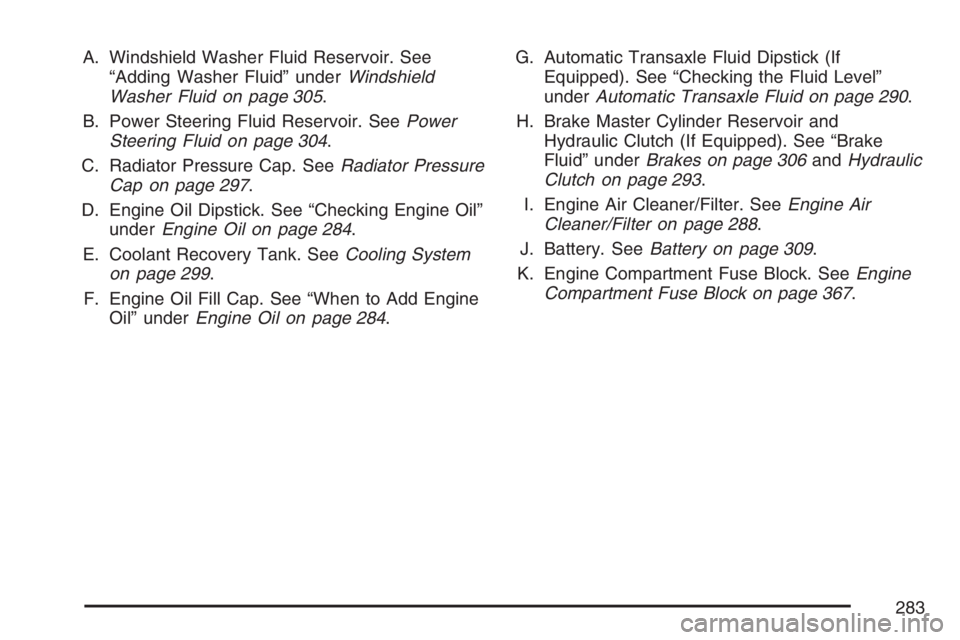
A. Windshield Washer Fluid Reservoir. See
“Adding Washer Fluid” underWindshield
Washer Fluid on page 305.
B. Power Steering Fluid Reservoir. SeePower
Steering Fluid on page 304.
C. Radiator Pressure Cap. SeeRadiator Pressure
Cap on page 297.
D. Engine Oil Dipstick. See “Checking Engine Oil”
underEngine Oil on page 284.
E. Coolant Recovery Tank. SeeCooling System
on page 299.
F. Engine Oil Fill Cap. See “When to Add Engine
Oil” underEngine Oil on page 284.G. Automatic Transaxle Fluid Dipstick (If
Equipped). See “Checking the Fluid Level”
underAutomatic Transaxle Fluid on page 290.
H. Brake Master Cylinder Reservoir and
Hydraulic Clutch (If Equipped). See “Brake
Fluid” underBrakes on page 306andHydraulic
Clutch on page 293.
I. Engine Air Cleaner/Filter. SeeEngine Air
Cleaner/Filter on page 288.
J. Battery. SeeBattery on page 309.
K. Engine Compartment Fuse Block. SeeEngine
Compartment Fuse Block on page 367.
283
Page 304 of 432
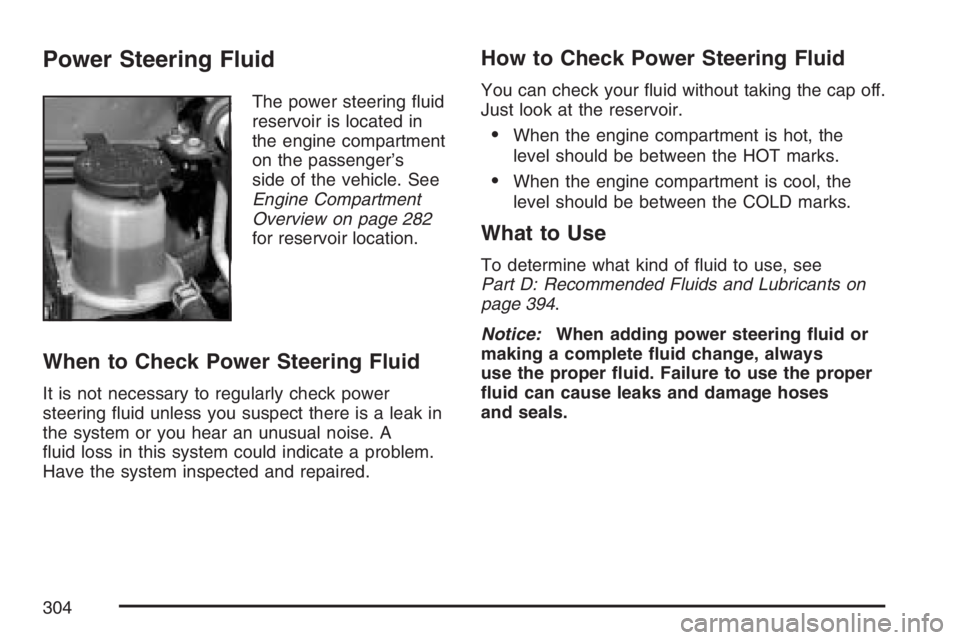
Power Steering Fluid
The power steering �uid
reservoir is located in
the engine compartment
on the passenger’s
side of the vehicle. See
Engine Compartment
Overview on page 282
for reservoir location.
When to Check Power Steering Fluid
It is not necessary to regularly check power
steering �uid unless you suspect there is a leak in
the system or you hear an unusual noise. A
�uid loss in this system could indicate a problem.
Have the system inspected and repaired.
How to Check Power Steering Fluid
You can check your �uid without taking the cap off.
Just look at the reservoir.
When the engine compartment is hot, the
level should be between the HOT marks.
When the engine compartment is cool, the
level should be between the COLD marks.
What to Use
To determine what kind of �uid to use, see
Part D: Recommended Fluids and Lubricants on
page 394.
Notice:When adding power steering �uid or
making a complete �uid change, always
use the proper �uid. Failure to use the proper
�uid can cause leaks and damage hoses
and seals.
304
Page 326 of 432
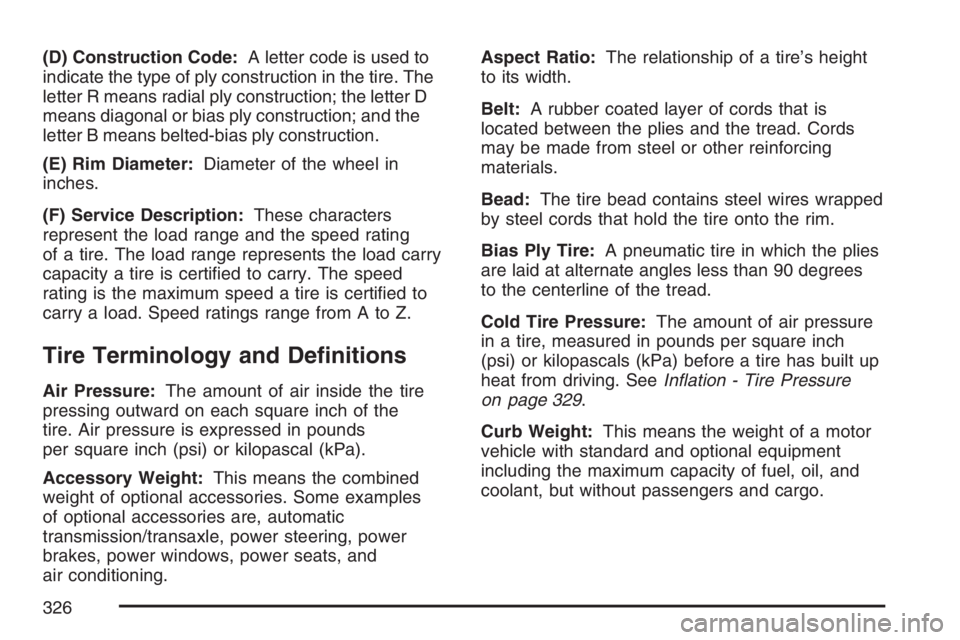
(D) Construction Code:A letter code is used to
indicate the type of ply construction in the tire. The
letter R means radial ply construction; the letter D
means diagonal or bias ply construction; and the
letter B means belted-bias ply construction.
(E) Rim Diameter:Diameter of the wheel in
inches.
(F) Service Description:These characters
represent the load range and the speed rating
of a tire. The load range represents the load carry
capacity a tire is certi�ed to carry. The speed
rating is the maximum speed a tire is certi�ed to
carry a load. Speed ratings range from A to Z.
Tire Terminology and De�nitions
Air Pressure:The amount of air inside the tire
pressing outward on each square inch of the
tire. Air pressure is expressed in pounds
per square inch (psi) or kilopascal (kPa).
Accessory Weight:This means the combined
weight of optional accessories. Some examples
of optional accessories are, automatic
transmission/transaxle, power steering, power
brakes, power windows, power seats, and
air conditioning.Aspect Ratio:The relationship of a tire’s height
to its width.
Belt:A rubber coated layer of cords that is
located between the plies and the tread. Cords
may be made from steel or other reinforcing
materials.
Bead:The tire bead contains steel wires wrapped
by steel cords that hold the tire onto the rim.
Bias Ply Tire:A pneumatic tire in which the plies
are laid at alternate angles less than 90 degrees
to the centerline of the tread.
Cold Tire Pressure:The amount of air pressure
in a tire, measured in pounds per square inch
(psi) or kilopascals (kPa) before a tire has built up
heat from driving. SeeIn�ation - Tire Pressure
on page 329.
Curb Weight:This means the weight of a motor
vehicle with standard and optional equipment
including the maximum capacity of fuel, oil, and
coolant, but without passengers and cargo.
326